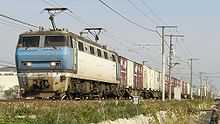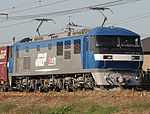JR Freight Class EF200
| Class EF200 | |
|---|---|
|
EF200-14 in revised livery, May 2009 | |
| Type and origin | |
| Power type | Electric |
| Builder | Hitachi |
| Build date | 1990–1993 |
| Total produced | 21 |
| Specifications | |
| UIC classification | Bo-Bo-Bo |
| Gauge | 1,067 mm (3 ft 6 in) |
| Bogies | FD3 (outer), FD4A (centre) |
| Wheel diameter | 1,120 mm (3 ft 8 in) |
| Length | 19,400 mm (63 ft 8 in) |
| Width | 2,970 mm (9 ft 9 in) |
| Locomotive weight | 100.8 t |
| Electric system(s) | 1,500 V DC |
| Current collection method | FPS2A pantograph x2 |
| Traction motors | AC |
| Performance figures | |
| Maximum speed | 110 km/h (70 mph) |
| Power output | 6 MW (8,000 hp) |
| Tractive effort | 26,600 kgf (261,000 N; 59,000 lbf) |
| Safety systems | ATS-PF, ATS-SF |
| Career | |
| Operator(s) | JR Freight |
| Number in class | 20 |
| Delivered | 1990 |
| First run | 1990 |
| Disposition | Operational |
The Class EF200 (EF200形) is a Bo-Bo-Bo wheel arrangement DC electric locomotive operated by JR Freight on freight services in Japan since 1992.[1]
Overview
The Class EF200 was developed to replace Class EF66 electric locomotives on heavy freight services on the Tokaido Main Line and Sanyo Main Line west of Tokyo.[1] It is equipped with six 1,000 kW (1,300 hp) FMT2 traction motors, giving a total power output of 6,000 kW (8,000 hp).[1] Ultimately, the class was deemed to be over-specified and unnecessarily expensive, and the order was terminated after the delivery of 20 full-production locomotives.[2] The subsequent Class EF210 was instead chosen as the standard design for hauling freight services on the Tokaido Main Line and Sanyo Main Line.[2] Originally designed to haul 1,600 t freight trains, problems of insufficient power supply capacity to the overhead lines, meant that the class was initially limited to hauling 1,200 t trains.[3]
Operations
As of 2012, the fleet consists of 20 locomotives (EF200-901 and EF200-2 – 20), based at Suita Depot in Osaka.[3] They are used primarily on 1,300 t freight trains west of Tokyo on the Tokaido and Sanyo Main Lines.[3]
Variants
- EF200-900: Prototype locomotive EF200-901, built 1990
- EF200-0: Full-production locomotives EF200-1 – 20, built 1992–1993
History

The prototype locomotive, EF200-901, was delivered in March 1990 for extensive testing.[3] The first full-production locomotives were delivered to Shin-Tsurumi Depot in Tokyo in 1992, entering revenue service on the Tokaido Main Line and Sanyo Main Line from the summer of that year.[1] In 1992, the Class EF200 was awarded the Laurel Prize, presented annually by the Japan Railfan Club.[4]
From 1 April 1999, the entire class was transferred from Shin-Tsurumi in Tokyo to Suita Depot in Osaka.[3] Between 2006 and 2009, the entire fleet was repainted into a new livery similar to that used for the later Class EF210 locomotives.[5] EF200-901 was repainted in 2007.[1]
From 2007, the class was power-derated to match the power output of the older Class EF66 locomotives.[2] In 2011, one class member, EF200-1, was withdrawn.[2]
See also
References
- ↑ 1.0 1.1 1.2 1.3 1.4 JR全車輌ハンドブック2009 [JR Rolling Stock Handbook 2009]. Japan: Neko Publishing. 2009. p. 39-40. ISBN 978-4-7770-0836-0.
- ↑ 2.0 2.1 2.2 2.3 JR機関車カタログ [JR Locomotive Catalogue]. Japan: Ikaros Publications Ltd. 20 June 2013. p. 40-45. ISBN 9784863207271.
- ↑ 3.0 3.1 3.2 3.3 3.4 ELダイヤ情報21 [Electric Loco Timetable Information 21]. Tokyo, Japan: Kotsu Shimbunsha. October 2012. p. 32-33. ISBN 978-4330320120.
- ↑ ブルーリボン賞・ローレル賞 選定車両一覧 [Blue Ribbon Award & Laurel Prize Winner List] (in Japanese). Japan: Japan Railfan Club. 25 May 2013. Retrieved 15 April 2014.
- ↑ "JR世代の機関車オールガイド" [Comprehensive Guide to JR Era Locomotives]. Tetsudō Daiya Jōhō Magazine (Japan: Kotsu Shimbun) 39 (315): 12–26. July 2010.
External links
| Wikimedia Commons has media related to JR Freight EF200. |
- JR Freight website (Japanese)
| ||||||||||||||||

